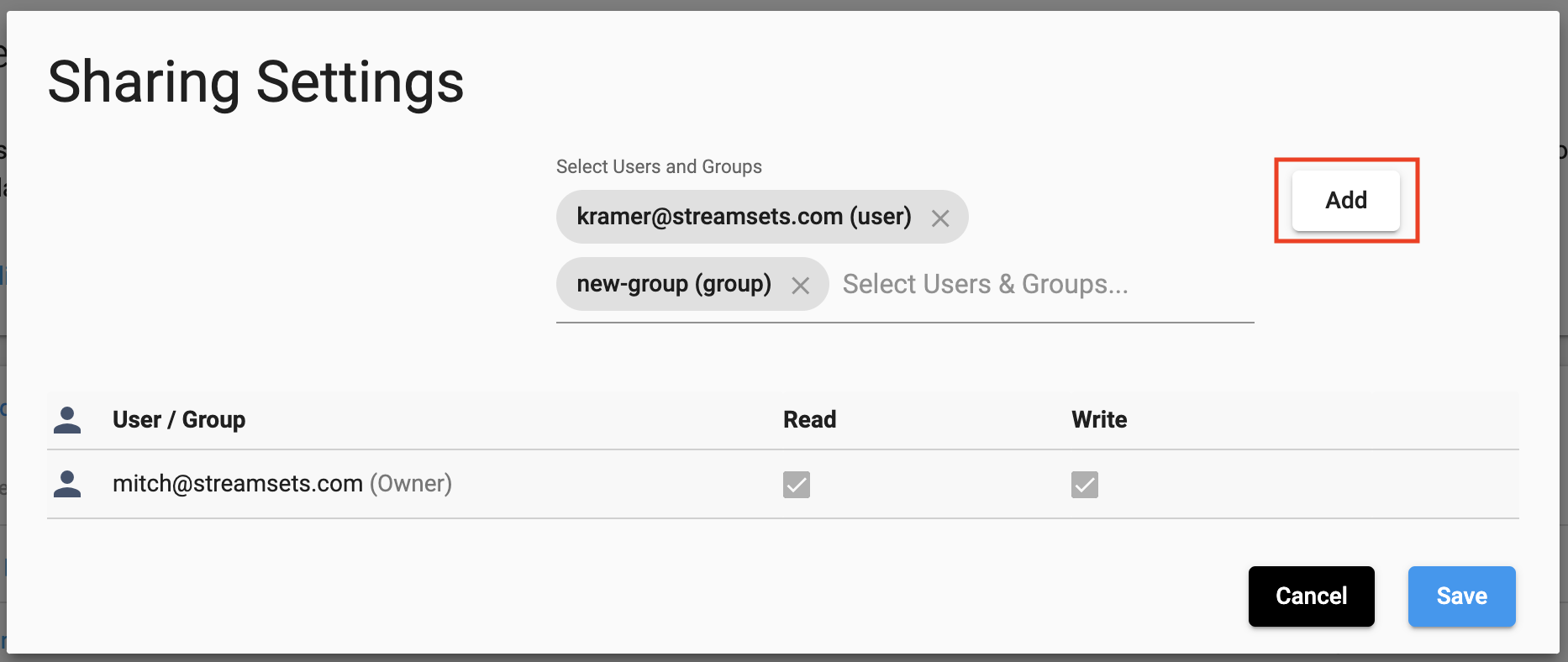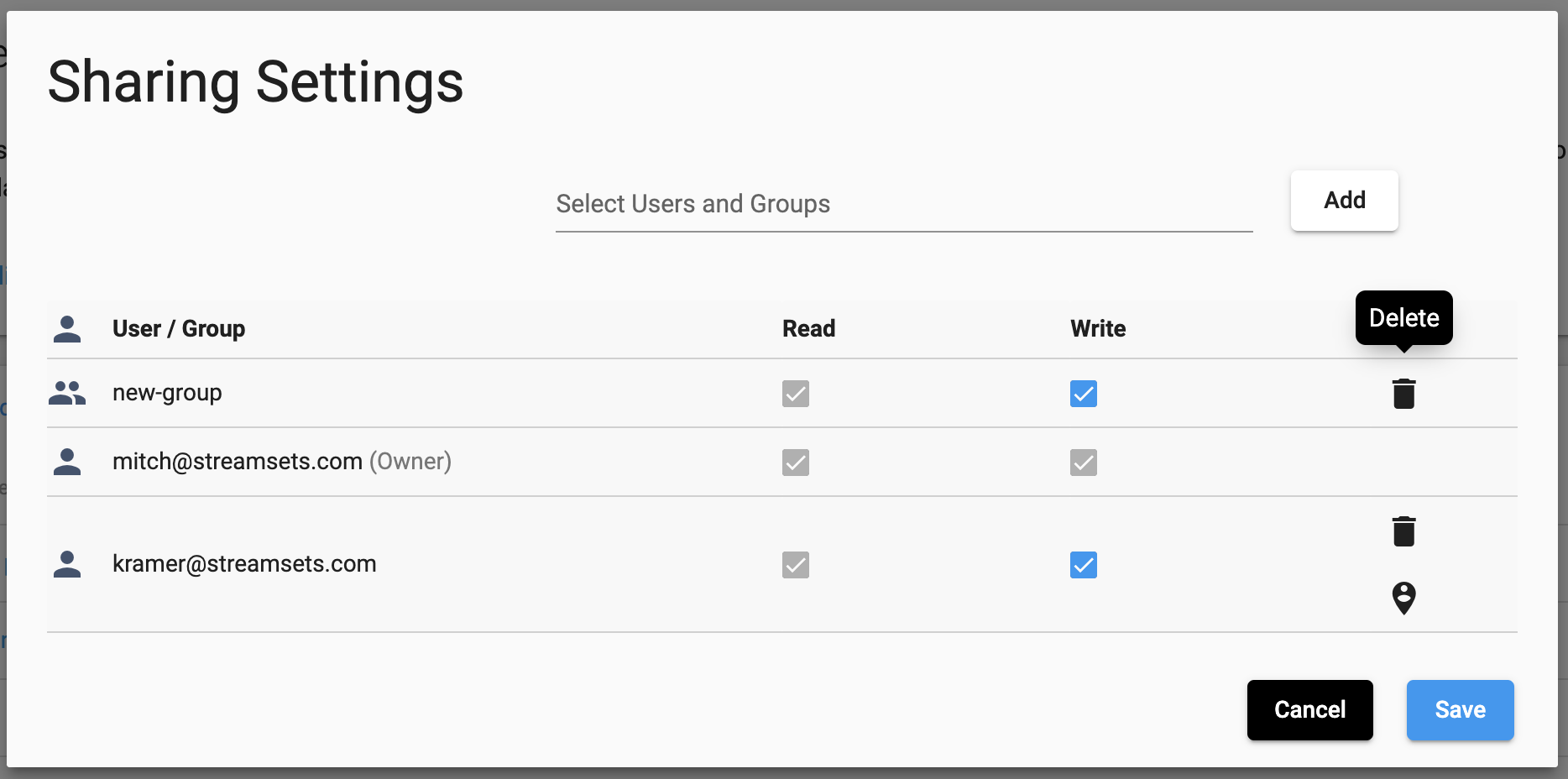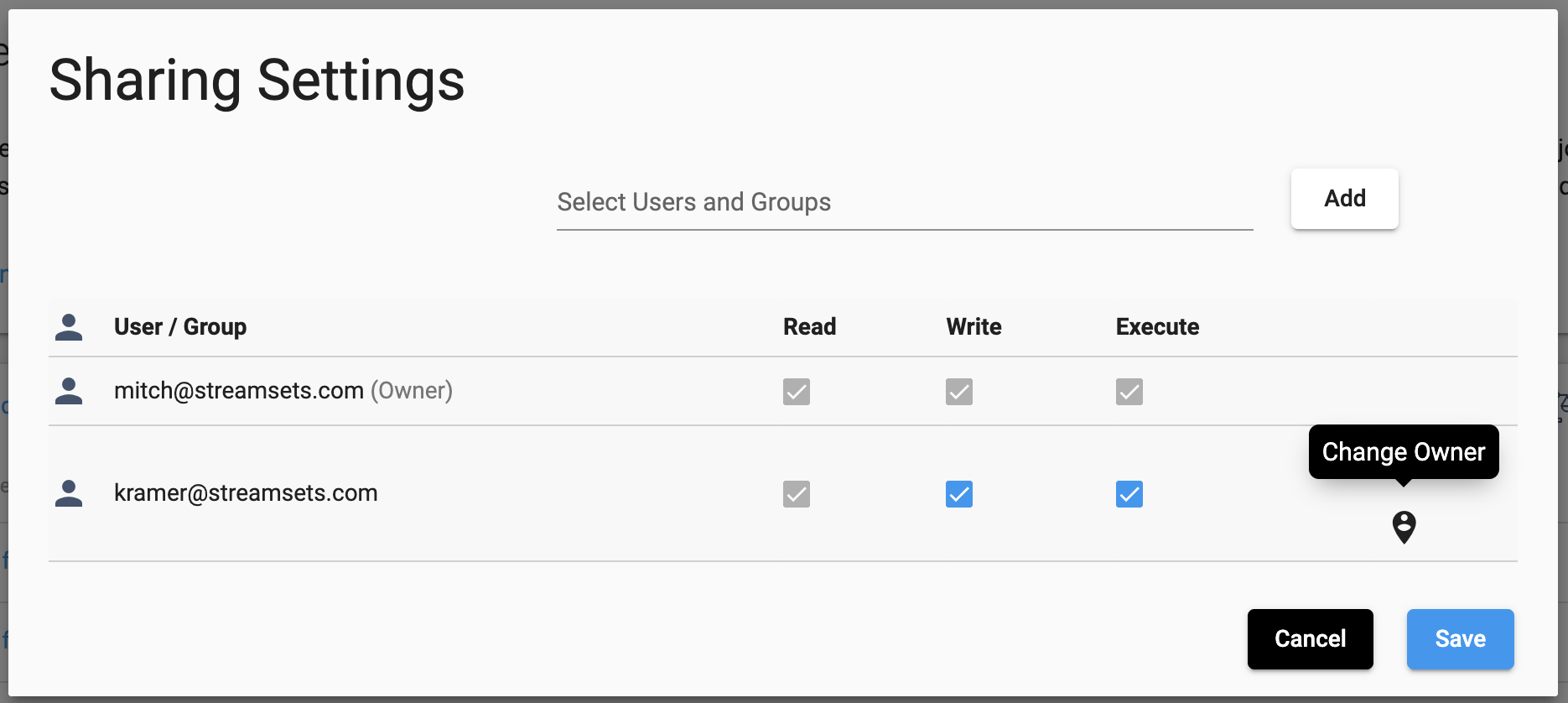Permissions
Section Contents
Permissions#
Permissions determine the level of access that users or groups have on certain objects. In the Platform SDK,
these are represented via streamsets.sdk.sch_models.ACL definitions (ACLs), which contain a list of
streamsets.sdk.sch_models.Permission instances for each subject. A streamsets.sdk.sch_models.Permission
instance stores the actions a user can take on the object.
ACLs do not exist as standalone objects in the SDK - they will always be contained within an object like a Job, Deployment, or Pipeline.
Tip
Accessing the ACL definition is the same for all objects in the SDK, regardless of their type. While not all objects
have an ACL, objects that do have ACL permissions will always have them stored under the acl attribute. Likewise,
the ACL will always have the structure of one permission definition per subject.
Find out more on Permissions in the StreamSets Platform Documentation.
Retrieving an Object’s ACL Permissions#
From the Platform UI, you can typically see the permissions assigned to an object by selecting the object and clicking on the ‘Share’ button as seen below:

This will show you the ‘Sharing Settings’ for the object, a breakdown of the permissions set for individual users and groups:

To retrieve an object’s streamsets.sdk.sch_models.ACL definition in the SDK, you can reference the acl
attribute of the object. For example, to retrieve the ACL permissions of a streamsets.sdk.sch_models.Topology
instance the following steps can be taken:
topology = sch.topologies.get(topology_name='ACL test topology')
# Show the ACL object for this Topology
topology.acl
# Show the specific permission definitions that are part of the ACL
topology.acl.permissions
Output:
# topology.acl
<ACL (resource_id=3a2c521b-074d-4bc4-a216-fd204bd63bed:791759af-e8b5-11eb-8015-e592a7dbb2d0, resource_type=TOPOLOGY)>
# topology.acl.permissions
[<Permission (resource_id=3a2c521b-074d-4bc4-a216-fd204bd63bed:791759af-e8b5-11eb-8015-e592a7dbb2d0, subject_type=USER, subject_id=71c0fe4b-e8b5-11eb-8015-a133d38af703@791759af-e8b5-11eb-8015-e592a7dbb2d0)>,
<Permission (resource_id=3a2c521b-074d-4bc4-a216-fd204bd63bed:791759af-e8b5-11eb-8015-e592a7dbb2d0, subject_type=GROUP, subject_id=pipeline_operators@791759af-e8b5-11eb-8015-e592a7dbb2d0)>]
Note
The subject_id format for an ACL permission varies based on whether it pertains to a user or group. A user’s
subject_id will be in the format user.id@organization.id, while a group’s subject_id will be in the format
group.id.
You can inspect an ACL definition’s actions to see the level of access a particular user or group has to the resource:
# Get the permission definition for a specific subject, the 'pipeline operators' group in this case
topology.acl.permissions.get(subject_id='pipeline_operators@791759af-e8b5-11eb-8015-e592a7dbb2d0').actions
Output:
['READ', 'WRITE']
Executable objects, such as streamsets.sdk.sch_models.ReportDefinition or streamsets.sdk.sch_models.Job
instances, also have an 'EXECUTE' action that indicates a user or group can execute the object in question, e.g.
running a job or generating a report definition.
job = sch.jobs.get(job_name='Job for ACL pipeline')
# Get the permission definition for a specific subject
permission = job.acl.permissions.get(subject_id='71c0fe4b-e8b5-11eb-8015-a133d38af703@791759af-e8b5-11eb-8015-e592a7dbb2d0')
# Show the actions set for that permission definition (the actions the user/group can take)
permission.actions
Output:
# permission.actions
['READ', 'WRITE', 'EXECUTE']
Adding or Updating ACL Permissions#
In the UI, adding new ACL permissions to an object, or updating the existing permissions, can be done in the same ‘Sharing Settings’ used to view existing user permissions. You can select the users or groups to add and then select the permissions, or modify the permissions of existing users:

Adding New ACL permissions to an Object#
To create a new permission definition for a user or group on an object using the SDK, the
streamsets.sdk.sch_models.ACLPermissionBuilder class is used. While it is possible to instantiate a new
streamsets.sdk.sch_models.ACLPermissionBuilder instance directly, most users will want to utilize the
builder that is already included within the streamsets.sdk.sch_models.ACL definition of an object.
The permission builder can be accessed directly via the streamsets.sdk.sch_models.ACL.permission_builder
attribute. It requires a subject_id, subject_type, and list of actions in order to build a permission definition. Once
the permission definition has been built, pass the permission definition to the streamsets.sdk.sch_models.ACL.add_permission()
method to add it to the object that owns the ACL:
pipeline = sch.pipelines.get(name='ACL pipeline')
# Retrieve the ACL definition of the pipeline
acl = pipeline.acl
# Create a list of actions to add for the new permission definition
actions = ['READ', 'WRITE']
# Get the user and group we want to set the permissions for
user = sch.users.get(email_address='kramer@streamsets.com')
group = sch.groups.get(display_name='new-group')
# Build the new permission definition for the subject_id (id), subject_type (user or group) and the
# actions to allow for this subject.
user_permission = acl.permission_builder.build(subject_id=user.id, subject_type='USER', actions=actions)
group_permission = acl.permission_builder.build(subject_id=group.id, subject_type='GROUP', actions=actions)
# Add the permission definition to the ACL
acl.add_permission(user_permission)
acl.add_permission(group_permission)
# Show that the permission definition was correctly added to the ACL
pipeline.acl.permissions.get(subject_id=user.id)
pipeline.acl.permissions.get(subject_id=group.id)
Output:
# pipeline.acl.permissions.get(subject_id=user.id)
<Permission (resource_id=b99b5d55-380d-45a5-b8f1-0c9345fb662f:791759af-e8b5-11eb-8015-e592a7dbb2d0, subject_type=USER, subject_id=aa172288-c804-11ec-ba8b-4930c98e80a9@791759af-e8b5-11eb-8015-e592a7dbb2d0)>
# pipeline.acl.permissions.get(subject_id=group.id)
<Permission (resource_id=b99b5d55-380d-45a5-b8f1-0c9345fb662f:791759af-e8b5-11eb-8015-e592a7dbb2d0, subject_type=GROUP, subject_id=new_group@791759af-e8b5-11eb-8015-e592a7dbb2d0)>
Updating Existing ACL Permissions on an Object#
Updating an existing permission definition for an object’s ACL is similar to creating a new permission definition. Rather than building a brand new permission definition, you modify an existing one in-place. Retrieve the object you wish to modify the ACL permissions for, retrieve the specific permission definition you want to update, and modify the actions as needed:
pipeline = sch.pipelines.get(name='ACL pipeline')
# Retrieve the permission definition for the subject to be modified
group = sch.groups.get(display_name='new-group')
permission = pipeline.acl.permissions.get(subject_id=group.id)
# Create a list of new actions that the permission definition will use
updated_actions = ['READ']
# Set the actions for the permission to the new 'updated_actions' list
permission.actions = updated_actions
# Show that the permission definition was correctly added to the ACL
pipeline.acl.permissions.get(subject_id=group.id).actions
Output:
# pipeline.acl.permissions.get(subject_id=group.id).actions
['READ']
Note
ACL Permissions are limited to following actions:
["READ"], ["READ", "WRITE"], ["READ", "EXECUTE"], or ["READ", "WRITE", "EXECUTE"].
Removing ACL permissions on an object#
Removing permissions for a user or group in the UI is also done from the ‘Sharing Settings’. Simply locate the user or group to delete permissions for, and select the ‘Delete’ button:

To remove an existing permission definition, the streamsets.sdk.sch_models.ACL.remove_permission() method
is used. You’ll first need to retrieve the specific permission you wish to delete from the ACL, and then pass it into
the method:
pipeline = sch.pipelines.get(name='ACL pipeline')
# Retrieve the permission definition for the subject to be removed
permission = pipeline.acl.permissions.get(subject_id='aa172288-c804-11ec-ba8b-4930c98e80a9@791759af-e8b5-11eb-8015-e592a7dbb2d0')
# Remove the permission definition from the ACL
response = pipeline.acl.remove_permission(permission)
Changing ownership of an object#
To change ownership of an object from the UI, the ‘Sharing Settings’ are used once again. You’ll need to locate the user to set as the owner (or add them to the permissions if they don’t yet exist), and select the ‘Change Owner’ button:

To find the ID of the current owner of an object from the SDK, you can reference the resource_owner
attribute of the ACL:
job = sch.jobs.get(job_name='Job for ACL pipeline')
# Show the ID of the resource_owner for this Job, defined in the ACL
job.acl.resource_owner
Output:
# job.acl.resource_owner
'71c0fe4b-e8b5-11eb-8015-a133d38af703@791759af-e8b5-11eb-8015-e592a7dbb2d0'
Changing ownership of an object is as simple as specifying a new resource owner in the ACL for the object. The resource owner value should be a valid user from the organization, specified using the ID of the user. Continuing on from the example above:
new_owner = sch.users.get(email_address='kramer@streamsets.com')
job.acl.resource_owner = new_owner.id